Types and varieties of codiaum (croton)

There is practically nothing more beautiful than brightly flowering plants. Thanks to breeders, wild species of various shapes, colors and sizes have been adapted for growing at home. One of the most prominent representatives of the flora is, of course, Codiaum.
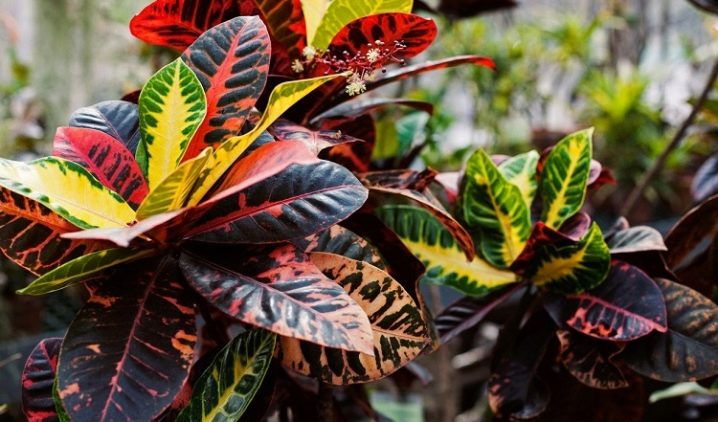
Peculiarities
The plant Codiaeum, according to scientific classification, belongs to the Euphorbiaceae family. Its 17 species have been identified as a separate genus. Of the wild species, the most famous is Codiaeum variegatum, it is he who is the ancestor of the varieties and hybrids known today, suitable for growing in an artificial environment created for him.
Very often variegated varieties derived from Codiaum are called crotons, but this, from a scientific point of view, is completely wrong. Confusion arose in the middle of the 18th century: because of similar characteristics, Karl Linnaeus mistakenly ranked Codiaum motley to the Croton genus.
And since all indoor varieties and hybrids were bred from Codiaum, they were mistakenly called crotons.
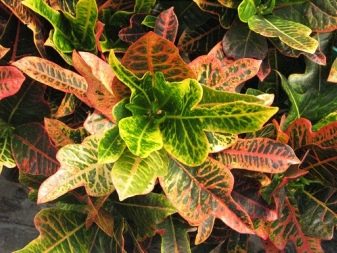
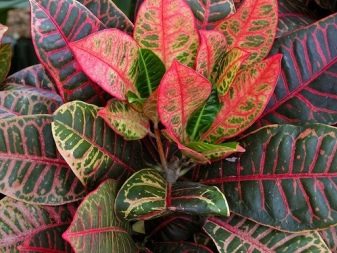
The motley codiaum got its name thanks to the Dutch naturalist Rumphis, who described it quite accurately at the end of the 17th century. Wild species of Codiaum prefer the territories of eastern India and Malaysia, in addition, there are excellent conditions for their growth on some Indonesian islands.
Variegated codiaeum (Codiaeum variegatum) - This is a plant with an erect branching stem and large leathery leaves, reaching 3, and in some cases 4 meters in height in natural habitat. To this size, Codiaum variegated can grow in a greenhouse, but not at home, in which the plant is unlikely to be higher than 70 cm.
The leaf plate is characterized by a rather variegated color. The veins on the foliage can have yellow, red, orange and even black tones. The leaf plate, depending on the subspecies, can have a linear, lanceolate, oval, lobed and even guitar-like shape. The edges of the foliage are also varied. For some, a sheet plate with edges twisted into a spiral is characteristic, for others, the edge of the sheet has a slightly wavy edge, and still others, in general, have an even edge.
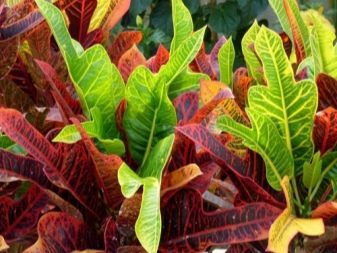
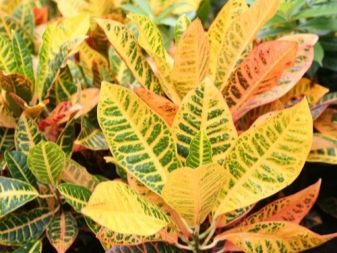
The forms of plants of the genus Codiaeum are quite diverse. Among the 17 known species, you can find trees, shrubs, and herbaceous plants. All of them have leaves different in shape and color, but there is also a similarity - white flowers with a yellow tint, grouped into inflorescences, the formation of which occurs in the leaf axils.
The leaves, depending on the species, can have a very different shape: ovoid or lanceolate, whole or lobed, with a straight edge or wavy, with a blunt outer tip or pointed. The colors of the color of the leaves are not inferior in the variety of forms: these are green, and yellow, and red, and red-brown and many more different shades present on individual parts of the leaf blade and petioles.
The color of young leaves is somewhat lighter in comparison with mature leaves.
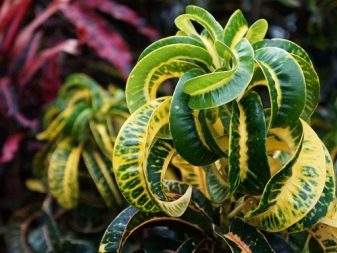
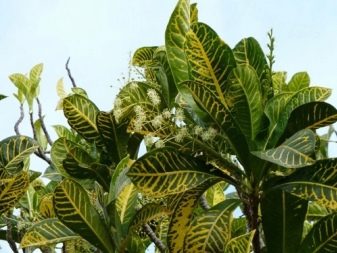
Varieties
The variety of forms needs to be classified, therefore, it is customary to systematize all plants of the genus Codiaum. A brief description of the appearance of plants is reduced to the structure and shape of the leaf plate. There are quite a few of them, but there are also common specimens.
For appendage (appendiculatum) characteristic plate, conditionally divided into 2 parts: upper and lower.A thin lintel serves as a connecting element between the halves; it is it that holds the beautifully hanging upper half, visually resembling a bell in its shape. The color of the leaf plate is predominantly in green tones, but specimens with variegated colors are also found.
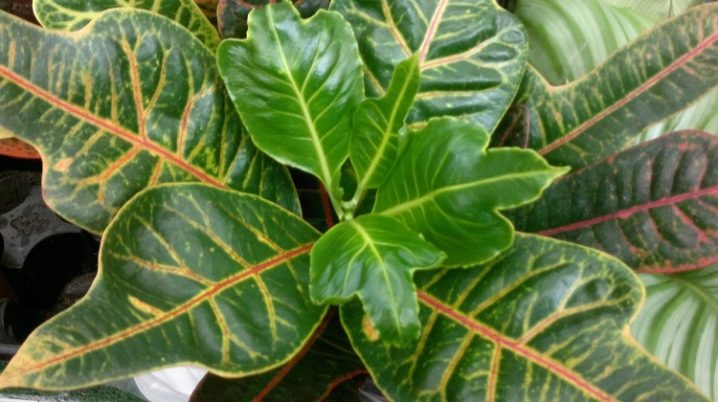
Have blade-shaped (lobatum) the leaf conventionally consists of blades, most often of them 3. This form is characterized by a shallow dissection of the plate with a longer and sharpened outside central part. The length from the tip to the base is about 21-22 cm, and the width does not exceed the mark of 8-10 cm. The color of the plate can be either monochromatic or variegated with patterns characteristic of a particular species in the form of spots or stripes.
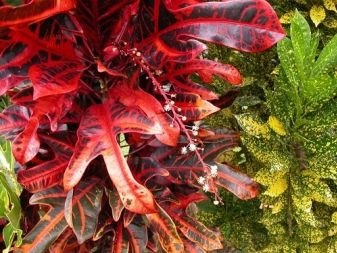

A striking representative of the 3-lobed form is the variety Excellence (Excellent). A distinctive feature of the variety is the shape and color of the leaves. The leaf plate of the plant is very similar in shape to an oak leaf, therefore it is often called the oaky Codiaum. Young leaves, located in the upper part of the shoot, are painted in green-yellow tones, more mature foliage growing in the lower part of the shoot has a burgundy-yellow, and some - and purple color.
Quite large leaves with clearly defined veins are located on a thin, but rather strong trunk in a tiled sequence.
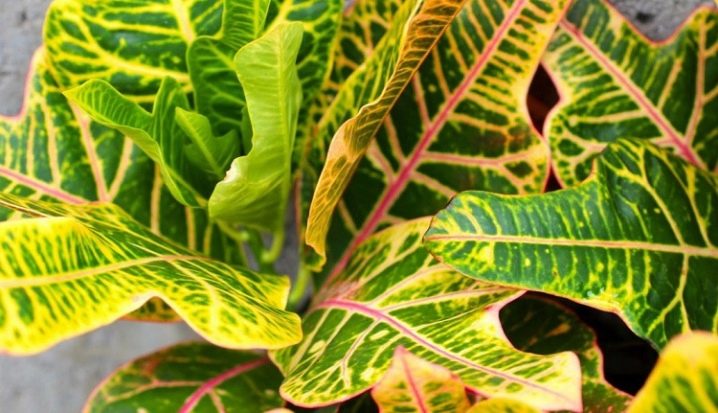
Another representative of the blade-shaped leaf plate is the variety Nervia. Visually, it resembles Excelent, it has the same dense and fairly large leaves. The shape of the leaf plate differs slightly: the lateral lobes are poorly expressed, and the edge of the leaf has small denticles. Depending on the age, the color of the leaves changes: young ones with a green color, older ones with yellow ones, and mature leaves have a pinkish tint.
The veins on the leaf plate acquire a burgundy-red hue as they grow.
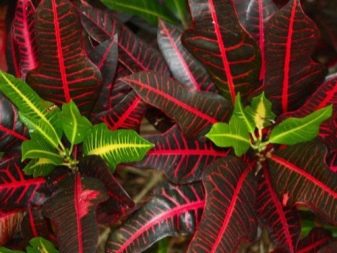
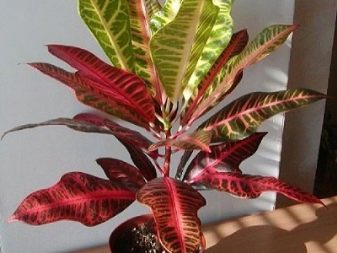
Aucuboid cultivar (Aucubifolium) it is distinguished by its beautiful leaves. The three-lobed leaf blade without clearly defined lateral lobes and apical part has a smooth edge. The color of the leaves varies with age. In young leaves, the plate is colored bright green, against the background of which lemon-colored spots are scattered in a chaotic manner, and more mature leaves have a rich green tone, diluted with yellow blotches.
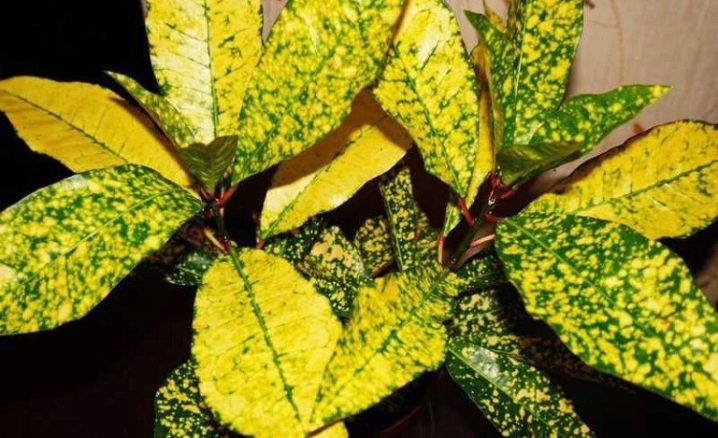
Variety Petra (Petra) belongs to the most popular and beloved by many species with a lobed leaf shape. In appearance, the plant resembles a low, but very beautiful tree with a dense crown. Its large leaves on long cuttings frame a rather sturdy trunk beautifully. Mostly oval-shaped leaf plates are colored dark green. The veins and edges of the leaves are bright yellow in color.
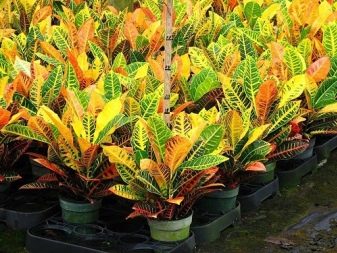

"Mrs. Aiston" characterized as Codiaum with a large number of leaves, densely growing along the entire length of the trunk. Narrow cuttings and slightly rounded from the outer edge of the leaf plates in the apical part of the trunk have a green tone, against which small specks of cream are visible. In mature foliage, the color is somewhat different, instead of creamy blotches as the plate grows, spots appear with a blurred border of yellow, pink, maroon and even black colors.
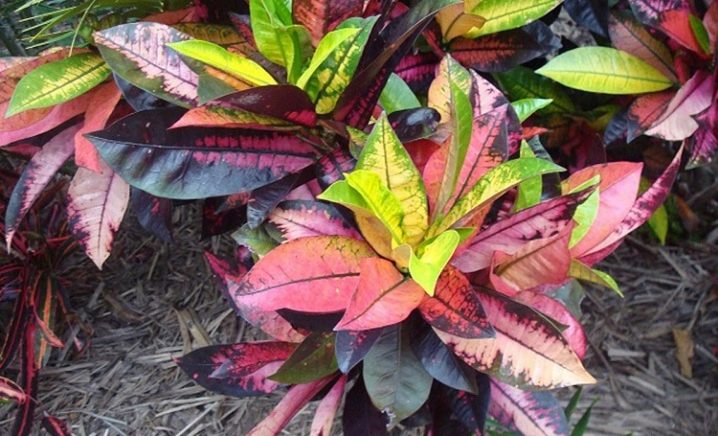
Mrs. Aiston is known for its varieties... Thanks to breeders, hybrids with different foliage colors were bred. Aiston red is characterized by dark red, almost black, leaves. Ayston has yellow foliage painted in yellow shades. The Disraeli variety is famous for its large, three-lobed leaf blades of green-yellow color in young leaves, brick-colored in mature leaves.
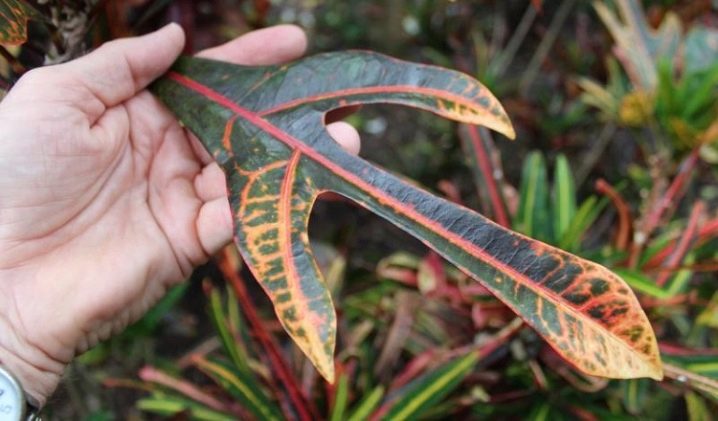
"Gold Sun" Is a variety with leathery ellipse leaves. The main background of the leaf plate is green, with large, often interspersed, yellow blotches. The length of the plant does not exceed 30 cm, but a fairly strong trunk is almost completely covered with foliage.
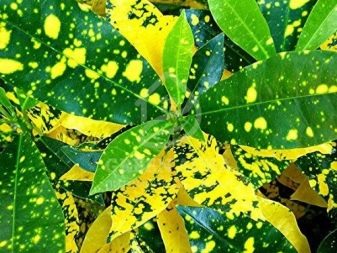
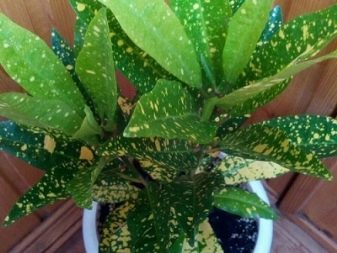
The narrow-leaved leaf shape is characteristic of many varieties and hybrids of Codiaum.
The most prominent representative is Codiaum Mummy. Its narrow, long, slightly curled leaf plates are colored, depending on age and hybrid, in a variety of shades. As a rule, dark green, red, yellow and pink shades predominate.
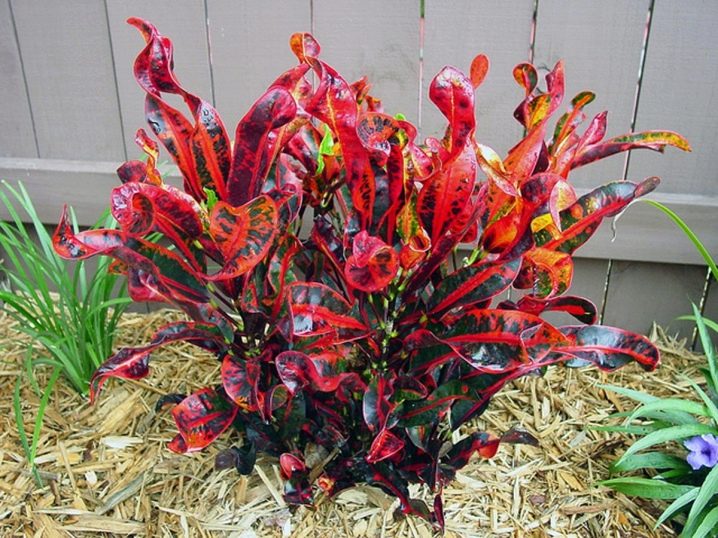
Sunny Star it is distinguished by its ability to grow in width, its numerous shoots with dense leathery leaves with a slight rounding at the ends form a beautiful lush bush. The color of the foliage ranges from light green with lemon dots to rich green with streaks and streaks of a reddish hue.
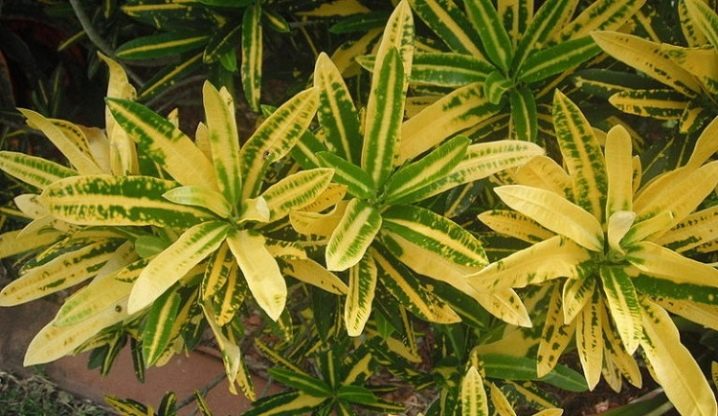
Zanzibar Is a variety with narrow leathery lanceolate leaves. A slightly curved leaf blade can have green, purple, yellow and burgundy hues.
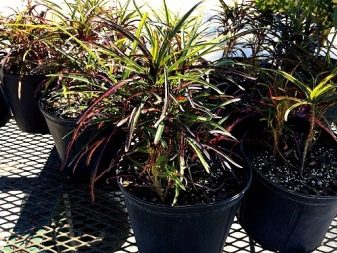
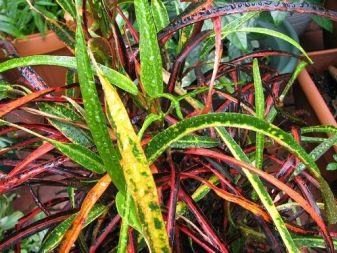
Codiaum Tamara belongs to the rarest varieties. It has very unusual foliage for a plant. Oval leaves with pointed tips and feathery edges are painted white. On a white background, small dark green specks are clearly visible, which are more concentrated in the central part of the leaf plate. The stem itself and leaf stalks are painted in a rich green color.

Codiaeum Pie Crust forms a beautiful sprawling bush of vertically growing leaves. The leaf blade is narrow, long, with a slightly wavy edge and a spicy pointed tip. Young leaves have a yellowish-green hue, and mature foliage is distinguished by a variegated pattern in pink-brown tones.
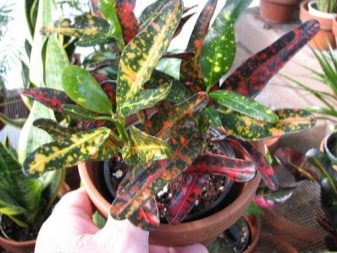

There are varieties that are difficult to classify as a specific leaf shape. Genuinna, with its varied in shape, length and width of leaf plates, belongs to such.
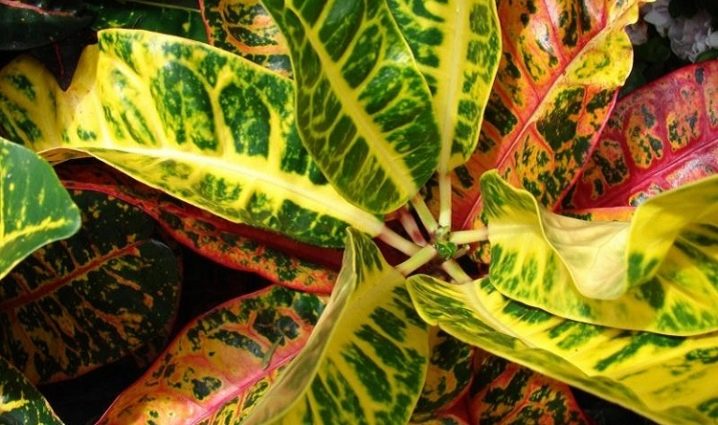
Have lanceolate the shape of the leaf tips has a blunt edge, and the narrow-leaved shape is characterized by pointed tips. The width of the lanceolate leaf plate exceeds the length by 3-4 times, and the width of the narrow-leaved plate is 9 times less than the length. There are also hybrids with medium and small leaf plate sizes, as well as varieties in which the leaves have beautiful ribbon bends. The color of the leaf plate, as a rule, has a bright yellow or grayish pattern with a metallic sheen.
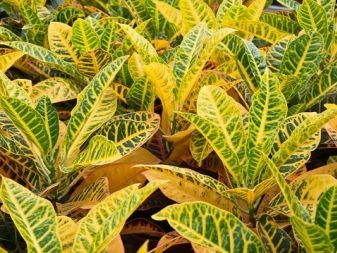
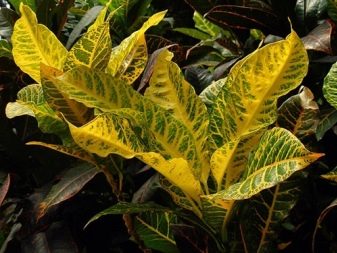
For small-leaved forms with its small, slightly curved or spirally twisted edges of the leaves, a reddish-yellow pattern with a scattering of small black dots over the entire surface is characteristic, and for the ribbon-like appearance, whose narrow leaves have short petioles, a green tone of the plate with small yellow blotches is characteristic.
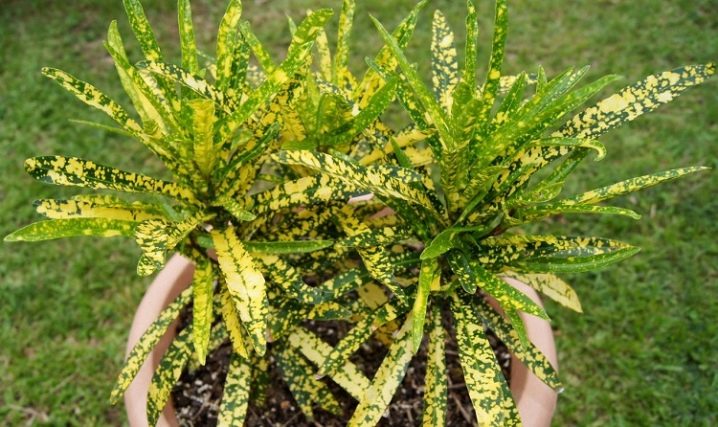
Moluccan the variety differs in that its leaf plates can be either oval or ovoid, or narrow lanceolate.
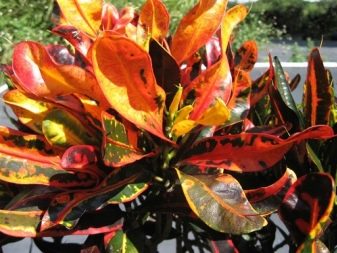
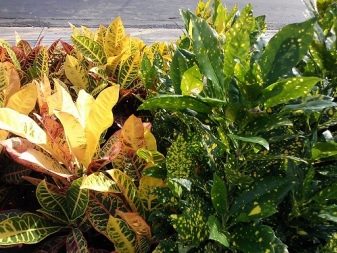
Home care rules
Indoor species of Codiaum are quite unpretentious in care, but like all plants, they need conditions that are as close to natural as possible.
First of all, you need to create the desired level of lighting. For all artificially bred varieties, bright light is needed, but you do not need to expose the flower pot in direct sunlight, burns of the leaf plate are possible.
If the window is on the south side, then the plant needs to be shaded, and if it is on the west or east side, then shading is not required.

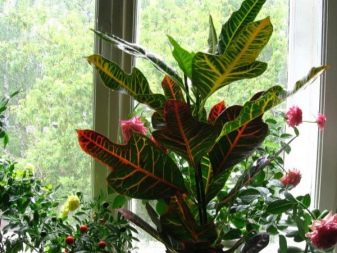
The optimal temperature regime for the Codiaum is in a moderate range. For the summer period, the temperature should not rise above 22C, and in the winter season, you need to ensure that it does not fall below 17-18C. In the summer, if there is a closed loggia, you can install a flower pot on the balcony, but make sure that there is no draft.
The plant tolerates regular spraying and abundant watering very well. The frequency of watering depends on the season. On hot summer days, watering should be at least 3 times, and in winter, one-time soil moistening is enough. It is easy to monitor the moisture content of the soil, the main thing is to prevent the top layer from completely drying out.
Although the codiaeum is unpretentious, it still needs feeding. For the summer period, lasting from March to August, liquid mineral fertilizers are used, which are watered to the plant no more than once a week.
For the winter period, the frequency is reduced to 1 time per month.
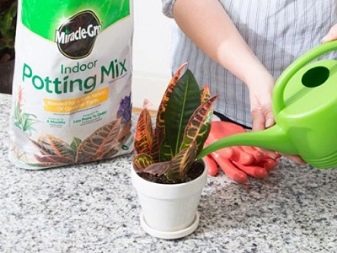

Adequate soil is required for good growth and development. Codiaum prefers slightly acidic substrates, which should contain sand, turf, humus and peat. Expanded clay should be present as drainage at the bottom of the tank, which will protect the plant from excess moisture, and therefore from rotting of the root system.
Adult specimens of Codiaum need replanting every 2-3 years, and young plants need to be replanted annually using the well-known transfer method.
If root rot, signs of fusarium, late blight and leaf blade spotting unusual for this variety are found, it is worth treating the affected areas with a fungicide.
Insecticidal preparations help from spider mites, mealybugs and scale insects.
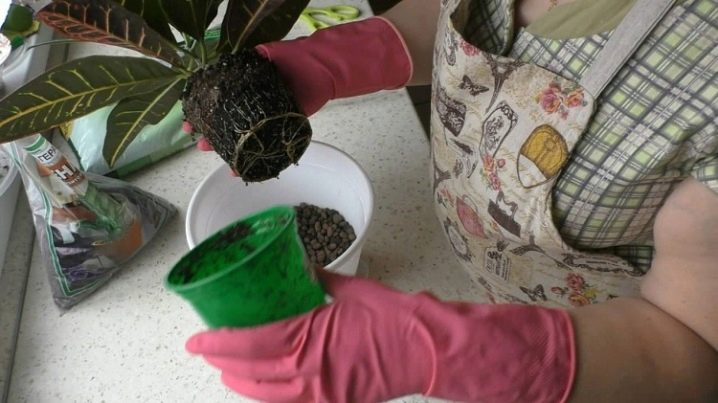
You can find tips on the content of Codiaum by watching the video below.


























The comment was sent successfully.